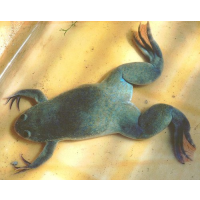Frogs with a Deadly Fungus Feared Worldwide Are All over the State
 African clawed frog (photo: Michael Linnenbach, commons.wikimedia.org)
African clawed frog (photo: Michael Linnenbach, commons.wikimedia.org)
African clawed frogs, imported into the United States decades ago as pets and for use in human pregnancy tests, have been identified as carriers of a fungus responsible for wiping out at least 200 frog species worldwide.
California researchers published their findings this week in the online journal PloS One. They established for the first time that the frogs are spreading Batrachochytrium dendrobatidis, known as Bd or chytrid, which was first described by scientists in 1999. The disease causes cardiac arrest in amphibians by thickening and hardening the skin, which interferes with their electrolytes.
Chytrid was called “the worst disease in vertebrate history” by one of the researchers, biologist Vance Vredenburg of San Francisco State University, although evolution has seen to it that the African clawed frog itself (Xenopus laevis) is now unaffected by it. Some scientists think chytrid is the greatest disease-driven loss of biodiversity in history.
Frogs are dying en masse in Australia, Europe, Latin America and western U.S. states. The Caribbean has been devastated.
“Here in California, it killed 99.9 percent of the populations of frogs in the mountains, Vredenburg told Inside Science. “It's driven literally hundreds of species of amphibians to extinction in other parts of the world.”
“African clawed frogs are well established in California,” according to the U.S. Geological Survey (USGS). They have been “established and invasive” across the state for decades, but are mostly in Southern California where, predicts the agency, the frogs will “continue to spread,” flourishing in irrigation canals and ditches that are regularly flooded with water.
Although the African clawed frog hasn’t been used in U.S. pregnancy tests since the 1970s, it is still a staple in scientific experiments, including stem cell research. Their importation is tightly controlled, but the hardy frogs, which can reportedly live in mud for years, have so far survived eradication efforts.
It was suspected as far back as 2004 that the African clawed frog was spreading the disease, but the new study was the first to confirm that.
While the published study advances the level of scientific knowledge about the disease and how it is being transmitted around the world, researchers appear no closer to coming up with a way to slow its deadly onslaught.
–Ken Broder
To Learn More:
African Clawed Frog Spreads Deadly Amphibian Fungus (by Jane J. Lee, National Geographic)
The Deadly Fungus Frogs Brought to the US (by Chris Gorski, Inside Science)
Frog Once Used in Pregnancy Tests Spread Deadly Fungus (by Sindya N. Bhanoo, New York Times)
California Frogs Once Used for Pregnancy Tests Carry Deadly Fungus (by Geoffrey Mohan, Los Angeles Times)
Xenopus Laevis (Daudin, 1802) (U.S. Geological Survey)
Prevalence of Batrachochytrium Dendrobatidis in Xenopus Collected in Africa (1871–2000) and in California (2001–2010) (by Vance T. Vredenburg, Stephen A. Felt, Erica C. Morgan, Samuel V. G. McNally, Sabrina Wilson and Sherril L. Green, PLoS One)
- Top Stories
- Controversies
- Where is the Money Going?
- California and the Nation
- Appointments and Resignations
- Unusual News
- Latest News
- California Forbids U.S. Immigration Agents from Pretending to be Police
- California Lawmakers Urged to Strip “Self-Dealing” Tax Board of Its Duties
- Big Oil’s Grip on California
- Santa Cruz Police See Homeland Security Betrayal in Use of Gang Roundup as Cover for Immigration Raid
- Oil Companies Face Deadline to Stop Polluting California Groundwater





